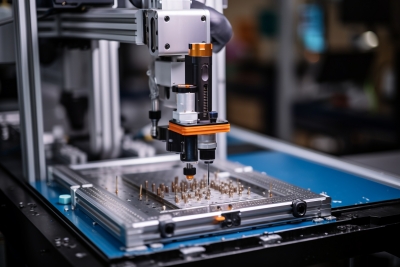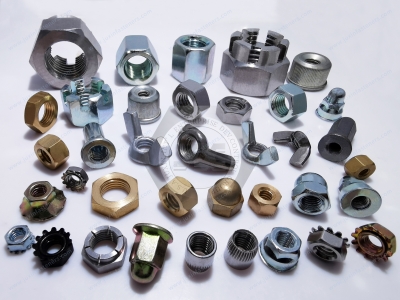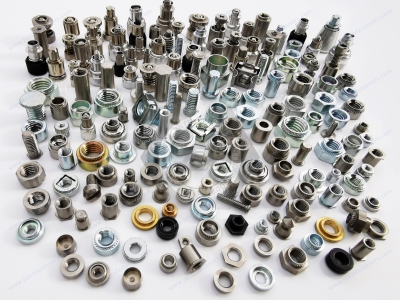Call Us
+86 136 6007 9809
Call Us
+86 136 6007 9809
Oct. 29, 2023
Surface treatment is one of the critical processes in fastener manufacturing; it is a treatment process to change the surface properties of fasteners, the purpose of which is to give anti-corrosion properties and a beautiful appearance to the product, but also to enhance the unique properties of fasteners, such as coating adhesion, electrical conductivity, weldability, abrasion resistance, reflective, decorative, insulating and so on. Commonly used surface treatment process characteristics and process parameters control requirements and plating/coating design can be used as a design reference for technicians.
一、Fasteners commonly used surface treatment introduction
Commonly used surface treatments for fasteners include zinc plating (colored zinc, yellow zinc, black zinc, white zinc, blue-white zinc, and green zinc), zinc-nickel alloy (silver-white, rainbow, and black), zinc-iron alloy, copper plating, chromium plating, phosphating (anti-corrosion), blackening (oxidation), zinc-aluminum coating (silver-gray and black), and electrophoresis, etc. This article focuses on the five most common surface treatments for fasteners, plating/coating characteristics, applications, etc. Now, we mainly introduce the five most commonly used surface treatment processes, plating/coating characteristics, And application occasions, etc. for zinc plating, zinc-nickel alloy, phosphating (anti-corrosion), zinc-aluminum coating, and electrophoresis, etc. for fasteners.
二、Common surface treatment plating/coating characteristics
1. Galvanized color: rainbow, yellow, black, white, blue-white, green.
Characteristics of galvanized plating: high surface hardness of plating; neutral salt spray test up to about 120h; heat resistance of plating ≤250℃; trivalent chromium zinc plating in line with environmental requirements; moderate processing costs.
Application scope of zinc plating: It is mainly applied to commonly exposed fasteners with low corrosion resistance and appearance requirements, and various suitable colors can be selected according to the requirements of the assembly location. It is especially ideal for bolts of grade 8.8 and below or nuts of grade 10 and down, including bolts of grade 10.9 in unimportant assembly parts.
2. Zinc-nickel alloy color: silver-white, black, colorful, grey, natural color.
Characteristics of zinc-nickel alloy plating: neutral salt spray test 720h; better heat resistance of the plating; heat-resistant ≤ 250 ℃; beautiful plating; higher processing costs.
The application scope of zinc-nickel alloy plating is mainly used in exposed grade 8.8 and 10.9 fasteners requiring high corrosion resistance, especially suitable for marine climates.
3. Phosphate color: black or black-gray.
Plating characteristics: neutral salt spray test 48~72h (with oil); phosphate film uniformity is good, almost no effect on the product size, a certain degree of abrasion resistance; particular phosphate film has a certain degree of insulating properties; heat resistance ≤ 150 ℃; the film is conducive to the later coating process; processing costs are moderate.
Scope of application: mainly used in fasteners in the box in contact with oil; fasteners that do not require high corrosion resistance and are matched with lock nuts; fasteners that need high thread through gauge; fasteners that need post-processing coating.
4, zinc aluminum coating color: silver gray, glossy black, matte black.
Characteristics of zinc and aluminum coating: heat resistance of the coating ≤ 300 ℃; neutral salt spray test 480 ~ 720h; no risk of hydrogen embrittlement; low hardness of the coating, not wear-resistant; higher processing costs; the coating meets the requirements of environmental protection.
Application scope of zinc and aluminum plating: mainly used in high corrosion resistance performance requirements and assembly of non-exposed high-strength fasteners, especially suitable for high-strength fasteners in automobile chassis parts.
Five 、Electrophoretic color: Glossy black.
Plating characteristics: The coating has the advantages of being smooth and uniform, beautiful, complex, and with good adhesion, corrosion resistance, and impact resistance.
Application scope: exposed fasteners and interior fasteners with specific corrosion resistance requirements.


三、 The standard surface treatment process introduction
1. Galvanized: galvanized according to the electrolyte is divided into two categories of alkaline and weak acidic, alkaline galvanized cyanide-free (zincate) galvanized and cyanide galvanized, acidic galvanized zinc chloride galvanized and sulfate galvanized, cyanide-free (zincate) galvanized and chloride (potassium chloride) galvanized is the fastener commonly used electroplating process.
Galvanizing process: loading → chemical degreasing → washing → pickling → washing → galvanizing → washing → light → washing → passivation → hot water washing → drying → discharging.
Galvanizing process control process parameters
(1) The purpose of the chemical degreasing process is to remove the oil on the product's surface to prepare for galvanizing. The primary material of the tank liquid is the degreasing agent (powder), and the main control process parameters are degreasing agent (powder) concentration, tank liquid temperature, degreasing time, and so on.
(2) The purpose of the acid washing process is to remove the product's surface oxidation and floating rust in preparation for galvanization. The primary material of the tank liquid is hydrochloric acid; the main control process parameters are hydrochloric acid concentration, pickling time, and temperature.
(3) Galvanizing: the primary materials of the tank solution are potassium chloride, zinc chloride, softener, and brightener. The main control process parameters are current density, galvanizing time, tank solution potassium chloride content, zinc chloride content, boric acid content, temperature, and PH value.
(4) Out of the light: the purpose of the process is to make the outside of the plating layer bright and beautiful. The primary material of the tank solution is nitric acid (nitric acid/water 30 ml/L), hydrochloric acid (hydrochloric acid/water five ml/L), the main control process parameters for the tank solution nitric acid content, out of the light time.
(5) Passivation: the purpose of the process is to generate the required color passivation film. The primary materials of the tank liquid are nitric acid, chromic anhydride, and sulfuric acid; the main control process parameters are tank liquid concentration, passivation time, and tank liquid PH value.
2. Zinc-nickel alloy
Zinc-nickel alloy process :loading→chemical degreasing→water washing→leaching activation→water washing→zinc-nickel alloy plating→activation→water washing→→passivation→water washing→closure→drying→discharging.
The primary materials for electroplating zinc-nickel alloy are sodium hydroxide, zinc oxide, cylinder opener, additives, brightening agent, nickel solution, hydrochloric acid, etc. Process control parameters can be found in the zinc plating process.
3、Phosphating
Phosphating process: loading → pre-greasing → water rinsing → degreasing → water rinsing → acid rinsing → water rinsing → activation → water rinsing → surface conditioning → phosphating → water rinsing → hot water rinsing → drying → dipping antirust oil → discharging.
Phosphating process control process parameters
(1) Pre-degreasing and degreasing: The purpose of the process is to remove the product surface oil. The primary material used is a degreasing agent. The main control process parameters for the concentration of the degreasing agent are tank temperature, degreasing time, and tank PH value.
(2) Water rinsing: This process aims to remove the residual acid left on the product's surface. The primary material used is tap water; the main control process parameters are rinsing time and PH value.
(3) Acid washing: The purpose of the process is to remove the product's surface, oxidized skin, and floating rust. The primary material used is dilute hydrochloric acid; the main control process parameters are hydrochloric acid concentration, temperature, and pickling time. For high-strength fasteners, the concentration of hydrochloric acid for pickling is generally 5% ~ 15%, with pickling time ≤ 2min.
(4) Activation process: the purpose is to activate the black chemical agent using the primary material for the dilute hydrochloric acid, the main control process parameters for the dilute hydrochloric acid concentration, and activation time.
(5) Surface conditioning treatment: the purpose of the process is to increase the activity, promote the formation of phosphating film, and accelerate the speed of phosphating while improving the fineness of the phosphating film. The use of the primary material for the surface conditioning agent, the main control process parameters for the surface conditioning agent concentration, surface conditioning time, and tank PH value.
(6) The phosphating process aims to form a phosphate-protective film on the product's surface. The primary material used is a phosphating agent; the main control process parameters are tank concentration, time, temperature, tank-free acidity, and total acidity.
(7) Water washing: The hot water washing process removes the product's surface electrolytes and impurities and improves corrosion resistance. The main control process parameters are washing time and temperature.
(8) The purpose of the drying process is to let the workpiece dry quickly to avoid surface rust and yellowing. The main control process parameters are drying temperature and time.
The above process parameters can be set concerning the materials used in the relevant manufacturer's instructions and product process quality to set and adjust.
4. Zinc-aluminum coating (organic coating)
Zinc aluminum coating process.
(1) One bottom side process: ultrasonic cleaning → shot blasting → coating (bottom coating) → baking and curing → top coating → baking and curing → discharging.
(2) Two bottom and one side process: ultrasonic cleaning → shot blasting → coating (bottom coating once) → baking and curing → coating (bottom coating twice) → baking and curing → top coating → baking and curing → discharging. The number of times zinc and aluminum coating is formulated according to the product's salt spray test requirements. The higher the salt spray test requirements, the higher the number of coating times, but generally three times. For products with a coefficient of friction requirements or to prevent the assembly process of high temperature "bite" phenomenon, generally need to carry out the top coating.
Zinc and aluminum process control process parameters
(1) Ultrasonic cleaning: the purpose of the process is to remove the product's surface grease and foreign matter. Process control degreasing tank liquid NaOH concentration, PH value (the best cleaning tank PH <8.5), temperature, and drying time. Tank PH value detection can be test paper or phenolphthalein reagent detection.
(2) Shot Peening: The purpose of the process is to remove surface rust and oxidized skin and, at the same time, increase the roughness of the surface, which is conducive to the later coating process. Process control product loading weight shot blasting time and steel shot diameter. For products with a slight pitch, to improve the quality of shot blasting and avoid jamming the steel shot, 0.2 stainless steel round and a flake mixture of steel shot can be used. Note that the products, after shot blasting, should be coated within 8 hours for coating processing. Product shot blasting quality is generally a commonly used copper sulfate CuSO4 test method for detection.
(3) Coating: The purpose of the process is to give the product on the bottom or top coating. The method controls the product temperature (generally 15℃﹤product temperature<35℃), dip coating time (about 15~30s), centrifugal speed (20~40rpm), centrifugal time (about 20~45s), centrifugal speed (200~400rpm). For coating, liquid mainly controls the coating's solid content, viscosity, and temperature.
(4) Baking and curing: The purpose of the process is to form a functional coating on the product's surface. The process controls the baking temperature (70~110℃ in the pre-baking area, and the temperature in the baking and curing area is determined according to the coating brand.) Baking time. Particular attention should be paid here to the curing temperature, which must be lower than the tempering temperature of the processed parts, to avoid the effect of baking temperature on the product's mechanical properties (such as hardness).


四、Design of Plating/Coating Thickness of Fasteners
Plating/coating thickness is the main factor affecting the corrosion resistance of the fastener and the screw ability of the threads; in the design of the plating/coating thickness, in addition to the consideration of corrosion resistance requirements, the following points should be considered:
(1) The thickness of plating/coating depends on the fundamental deviation of the threads, so the maximum accommodating layer thickness of the thread pitch must be considered;
(2) To ensure adequate strength of fastener threads, the size of the thread center diameter before plating/coating should be no less than the e-tolerance band requirement;
3) For plated/coated finishes, the effect of uneven plating/coating thickness on the product is to be considered;
(4) The geometrical relationship between plating/coating thickness and thread center diameter size should be considered. Generally, the plating/coating thickness should be ≤ 1/4 thread fundamental deviation, i.e., a ≤ 1/4 es (where: a is plating/coating thickness and es is deviation).
With the technological improvement of the surface treatment industry, the product's corrosion resistance can be improved by applying sealer. So, the plating/coating thickness does not have to be designed very thick to meet the corrosion resistance requirements of the product.
Therefore, to ensure the screwing and interchangeability of fastener threads, the thread accuracy of the finished product is often designed as follows: external threads are six h, and internal threads are six h. The plating/coating thickness of fasteners with external threads is designed to be 8μm~12μm, and the plating/coating thickness of fasteners with internal threads is designed to be 5μm~8μm.
For fasteners plated/coated before thread accuracy dimensions, according to the plating/coating thickness, select the appropriate thread tolerance zone, commonly used: external threads for 6g, 6f, 6e three tolerance zones; internal threads for 6H, 6G two tolerance zones.
五、Commonly used surface treatment plating/coating selection
In selecting fastener surface treatment plating/coating, one must simultaneously fully consider the fastener's characteristics, the assembly process, the service environment, processing costs, and other factors to select the fastener surface treatment type reasonably.
The choice of fastener surface treatment plating/coating should be based on the fasteners commonly used in various plating/coating characteristics while giving full consideration to the product's characteristics, structural features, use of the environment, corrosion-resistant performance requirements, and other factors, at the same time, but also need to consider the cost of high and low, as far as possible, do not want to overdesign the quality.
1、 Selection according to product characteristics
(1) For products with high thread accuracy requirements or small dimensional tolerances, one should try to choose a good performance of thin plating/coating film and better uniformity of the surface treatment;
(2) For products with blind holes and small holes in the structure, try not to choose plating type of surface treatment if better quality of surface treatment is required;
(3) For fasteners and high hardness standard parts in critical parts of grade 10.9 and above, try to choose the surface treatment with no risk of hydrogen embrittlement during processing;
(4) For thin-walled, easily deformed, thin and small spacers, screws with a slight pitch combination of screws, screws, and other products within the wrench screwing structure should try to choose the surface treatment processing process does not lead to deformation of the surface treatment. Avoid using resin plating/coating to avoid drying gaskets and combinations of mutual adhesion to prevent threads and holes from accumulating liquid and affecting the assembly.
5) For fasteners with weldability requirements, try to use a "natural color" rust prevention treatment. If you must use the surface treatment, choose a better conductive plating/coating, but do not do a "closed" treatment.
(6) For conductive or insulating requirements, fasteners should be used for conductive or insulating better plating/coating.
2. Select according to the service environment of the product
(1) According to the service environment temperature, choose the plating/coating with suitable temperature resistance and thermal conductivity to avoid early failure of plating/coating;
2)According to the material characteristics of the connecting parts, choose the suitable plating/coating to avoid chemical corrosion caused by mutual reaction with the surface of the connecting parts;
(3) For the fasteners in the box in contact with lubricating oil and cooling oil, plating/coating that is not easy to come off and does not chemically react with the oil should be selected;
(4) According to the environment of the product's corrosion resistance requirements for Selection, the higher the product's corrosion resistance, the higher the manufacturing cost, and it must be reasonable to consider the economy.
3. According to the assembly requirements for Selection
(1) The assembly of exposed fasteners should be used for the appearance of beautiful, corrosion-resistant performance and better plating/coating. The hardness of the film layer is suitable for the assembly process and will not be caused by friction with the assembly tool between the shedding. The color should connect with the parts' color to maintain consistency.
(2) The assembly process to produce stretching and bending deformation of the fasteners, we choose a better toughness and lower hardness of the plating/coating, and the film thickness should not be too thick to avoid the failure of the plating/coating after assembly.
(3) the surface treatment that is more suitable for painting should be selected for fasteners that need to be painted after assembly. Consideration should also be given to whether the plating/coating will affect the performance when cleaned before painting.
If you are looking for high-quality fastener screws & all kinds of fasteners or technical support for structural design, please get in touch with me.adelajonly@gmail.com. Thanks.
Website: www.juxinfasteners.com
Contact Us
Tel.:
+86 020 8621 0320
+86 020 3121 6067
Technical Support:
Navigation
SEND INQUIREY